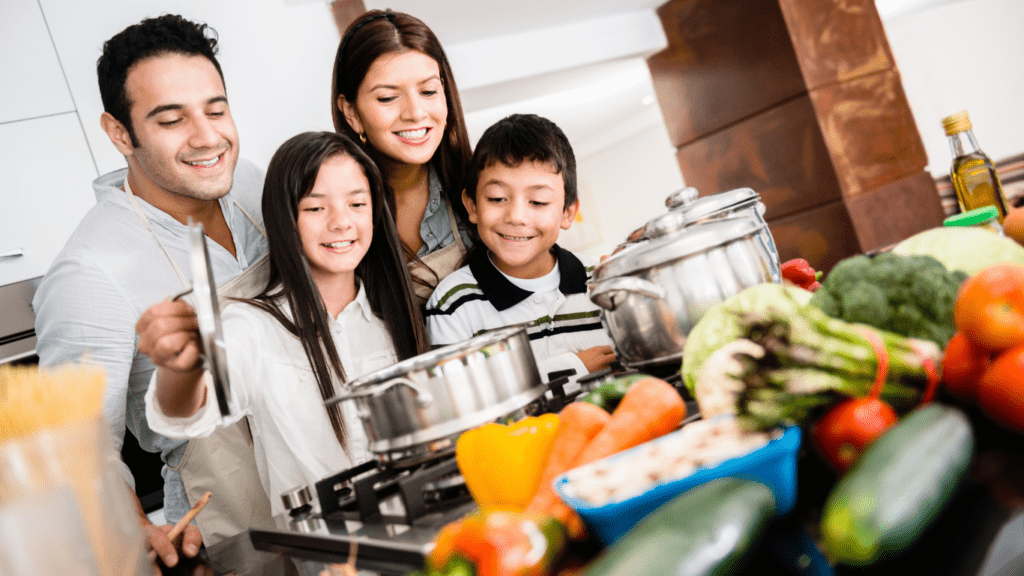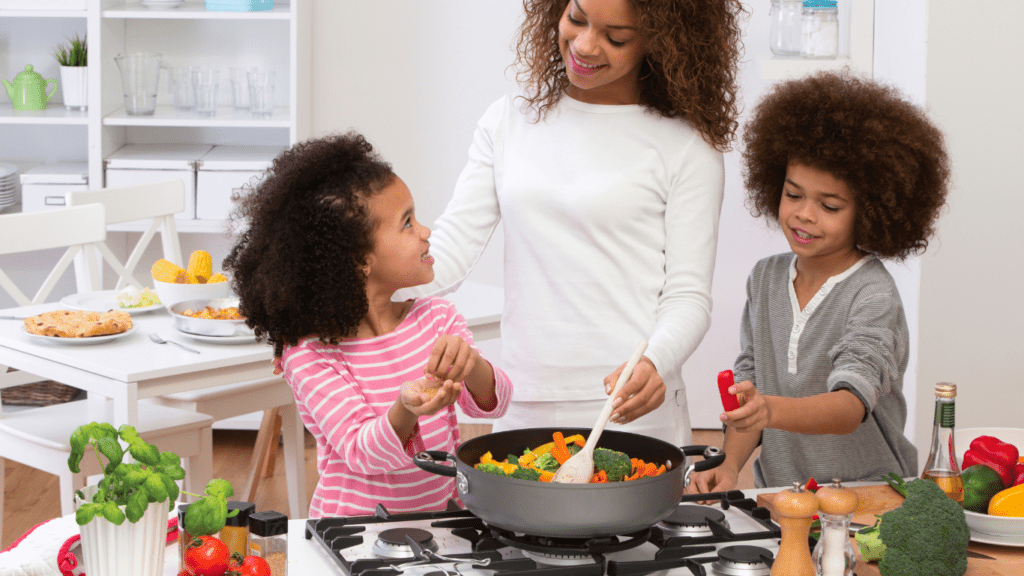Cooking has always been more than just a way to prepare meals—it’s a chance to connect, create, and care for the people we love. When families cook together, it’s not just about making delicious food; it’s about building memories, fostering teamwork, and encouraging healthier habits. Plus, involving everyone in the kitchen can make even the pickiest eaters excited about trying something new.
The Benefits Of Cooking Together For Better Health
Cooking together creates opportunities for improved health and stronger family connections. Shared kitchen experiences foster collaboration, improve dietary decisions, and introduce essential life skills.
Strengthening Family Bonds
Group cooking strengthens family relationships by creating moments of teamwork and communication. When everyone participates in meal preparation, it builds a sense of responsibility and cooperation. For example, assigning specific tasks like:
- chopping vegetables
- setting the table
- mixing ingredients
ensures everyone feels involved. These shared experiences add value to family time, replacing distractions like screens with meaningful interaction.
Encouraging Healthy Eating Habits
Collaborative cooking encourages better food choices by involving everyone in ingredient selection and meal planning. Families gain awareness of fresh, whole foods and reduce dependence on processed items. For instance, preparing a colorful vegetable stir-fry together can make younger family members more eager to try new vegetables. Studies from journals like the Journal of Nutrition Education and Behavior highlight that children who help cook meals often consume more fruits and vegetables.
Building Lifelong Skills
Cooking together builds practical skills that support independence and confidence in the kitchen. Measuring ingredients, understanding nutritional content, and following recipes teach critical thinking and organization. Children learn how to prepare balanced meals, while adults expand their knowledge of healthy alternatives. Practical skills like recognizing portion sizes or substituting unhealthy ingredients with healthier options have long-term benefits.
Key Ingredients For Family-Friendly Recipes
I focus on using wholesome, flavorful, and accessible ingredients when creating family-friendly recipes. These choices make meals nutritious and appealing to everyone.
Choosing Nutritious Whole Foods
I prioritize whole foods like fresh fruits, vegetables, lean proteins, and whole grains. For example, spinach, carrots, chicken breast, and quinoa provide essential nutrients while being versatile. Minimally processed foods are the cornerstone of healthy family meals, as they retain natural vitamins and minerals. These options also ensure that meals remain balanced.
Incorporating Diverse Flavors
I include a variety of herbs, spices, and seasoning blends, such as basil, cumin, or garlic powder, to enhance taste without relying on excessive salt or sugar. Building layers of flavor keeps meals exciting and encourages adventurous eating, particularly for kids. Ingredients like soy sauce or lemon juice bring global tastes to familiar dishes without overwhelming young palates.
Keeping It Simple And Fun
I choose uncomplicated recipes with manageable ingredients and steps, like one-pot pastas or sheet-pan dinners, to make cooking stress-free. Fun presentation, like cutting vegetables into shapes or involving kids in mixing, adds an interactive element. Quick preparation helps families focus on the enjoyment of cooking together without the pressure of complexity.
Top Family-Friendly Recipes Everyone Will Love

Cooking together becomes more enjoyable with easy, delicious meals everyone in the family can appreciate. Below are ideas for breakfast, lunch, and dinner to suit all ages and dietary preferences.
Breakfast Ideas To Kickstart The Day
Starting the day with a nutritious breakfast benefits everyone in the family. I recommend recipes that are quick to make, adaptable, and full of flavor.
- Overnight Oats: Combine rolled oats, milk or a dairy alternative, and favorite toppings like fresh fruit, chia seeds, or nuts. Let it sit in the fridge overnight for a no-mess, grab-and-go breakfast.
- Veggie Packed Egg Muffins: Whisk eggs and mix in diced bell peppers, spinach, and shredded cheese. Bake in a muffin tin at 375°F for 20-25 minutes. These are easy to make ahead and serve warm or cold.
- Whole Grain Pancakes: Mix whole wheat flour with mashed banana, low-fat milk, and a splash of vanilla. Cook in a skillet for fluffy, nutrient-dense pancakes. Top with fresh fruit or a drizzle of honey.
Quick And Healthy Lunch Options
Midday meals balance energy levels while keeping preparation stress-free. These family-friendly ideas help maximize nutrition without losing flavor.
- Turkey and Avocado Wraps: Spread hummus on a whole grain tortilla, layer sliced turkey, avocado, spinach, and shredded carrots, then roll tightly. Slice for pinwheels to make it more kid-friendly.
- Mason Jar Salads: Layer ingredients like quinoa, cherry tomatoes, cucumbers, grilled chicken, and dressing in a mason jar for a portable, fresh option. Shake just before eating.
- Mini Pita Pizzas: Use whole grain pita bread as a base, spread marinara sauce, sprinkle shredded mozzarella, and add mixed veggies for toppings. Bake for 10 minutes at 400°F until cheese is bubbly.
Creative Dinner Recipes For All Ages
Evening meals bring the family together. These recipes balance taste and nutrition while being simple enough for everyone to assist.
- One-Pot Chicken and Rice: Combine chicken thighs, brown rice, garlic, carrots, peas, and chicken broth. Simmer until rice is cooked and flavors meld perfectly, cutting down cleanup.
- Sheet-Pan Veggies and Sausage: Toss sliced zucchini, bell peppers, sweet potatoes, and chicken or turkey sausage with olive oil and Italian seasoning. Roast at 425°F for 25-30 minutes.
- DIY Taco Night: Use whole grain tortillas, lean ground beef or grilled fish, and a variety of toppings like shredded lettuce, diced tomatoes, and guacamole. Let everyone build their own taco to customize flavors.
These recipes enhance the cooking experience while promoting shared laughter, teamwork, and healthy eating habits.
Tips For Making Cooking Together Enjoyable
Cooking together becomes more enjoyable when the experience is fun, organized, and collaborative. Simple strategies can transform kitchen time into meaningful family moments while keeping stress levels low.
Assigning Roles In The Kitchen
Clear roles streamline the process and keep everyone involved. I encourage assigning tasks based on each family member’s age and skill level. Younger kids can wash produce, stir ingredients, or set the table, while older children and adults can tackle chopping, cooking, or seasoning. Rotating roles for variety ensures everyone gains different skills over time. For example, one week a child might mix batter, and another week they can sprinkle toppings.
Making Cleanup A Team Effort
Shared cleanup makes the process less daunting and fosters teamwork. I suggest allocating post-meal tasks like loading the dishwasher, wiping counters, or sweeping the floor to individual family members. Making cleanup part of the routine strengthens responsibility and speeds up the process. To keep the mood light, I often set a timer or play upbeat music to make tidying up feel like less of a chore.
Adding A Fun Spin To Recipe Preparation
Injecting creativity into cooking engages everyone. I like suggesting decorating cookies, designing personal mini pizzas, or plating meals creatively. Letting kids choose toppings or name their dishes adds excitement to routine meals. Incorporating games, such as guessing spices by smell or competing to chop vegetables faster (safely), encourages active participation.





